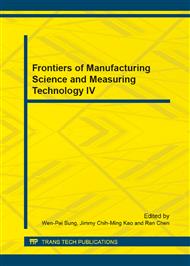[1]
Ning Li, Qinglin Meng, Peng Wang. Study on Nano Transparent Thermal Insulated Glass Paint [J]. Science Technology and Engineering, 2009, 9 (21): 6421-6424.
Google Scholar
[2]
Lijun Chen, Fengqin Wu. Preparation and characterization of nano-ATO colloid suspension [J]. The Institution of Engineering and Technology, 2012, (7): 248–251.
Google Scholar
[3]
Rodrigues E C P E, Olivi P. Preparation and characterization of Sb2doped SnO2 films with controlled stoichiometry from poly-meric precursors [J]. J Physics Chemistry of Solids, 2003, 64(7): 1105-1112.
DOI: 10.1016/s0022-3697(03)00003-9
Google Scholar
[4]
Shuxiang Luo, Zhen Song, Junling Li. Research on the dispersion uniformity and stability of nano-ATO [J]. Journal of functional materials, 2013, 44(11): 1603-1606.
Google Scholar
[5]
Sheng Gong, Zecheng Chen, Fulong Tang, Pihui Pi, Xiufang Wen, Dafeng Deng, Jiang Cheng, Zhuoru Yang. Preparation and characterization of antimony doped tin oxide Nan particles [J]. Journal of the Chinese ceramic society, 2009, 37(4): 648-652.
Google Scholar
[6]
Xushan Huang, Weizhong Lu, Zhongkuan Luo, Lixin Song. A study on the influencing factors in the preparation of bismuth-doped Tin Oxide nano-powders by co-precipitation [J]. FineChemicals, 2011, 28(9): 843-847.
Google Scholar
[7]
Jing Zhang, Wei He, Qitu Zhang. Synthesis and Characterization of ATO Nanoparticles by Coprecipitation Reaction [J]. Journal of Materials science & engineering, 2009, 27(2): 225-228.
Google Scholar
[8]
Baoping Yang, Xiaohua Zhong, Xiaoliang Zhang, Jinfeng Cui, Junhong Jia, Gewen Yi. Effects of Sb content on the structure and electric property of ATO nanoparticles [J] Journal of functional materials, 2011, 42(11): 1993-(1996).
Google Scholar
[9]
Ming Li, Yi Shen, Xinxin Zhang, Lan Liu. Study on HAP Ultra fine Powder Prepared by Citric Acid as Dispersant [J]. Portland Bulletin, 2006, (2)101-103.
Google Scholar
[10]
Shimin Liu. Preparation and application of transparent conductive tin-based oxide Nan powders [D]. Dalian Jiaotong University, (2011).
Google Scholar
[11]
Guilan Gao, Xuecheng Duan. Preparation and characterization of nanometer ATO powder [J]. New Chemical Materials, 2012, 38(2): 15-17.
Google Scholar
[12]
Chengqiang Pan. Nano structure ATO and composite prepared and its electrochemical properties [D]. DongHua University, (2012).
Google Scholar
[13]
Xiongping Li, Jieda Wu, Chuanyou Han. Preparation and Characterization of Antimony-doped Tin Dioxide [J]. Chemical word, 2006, 47(4): 196-198.
Google Scholar


